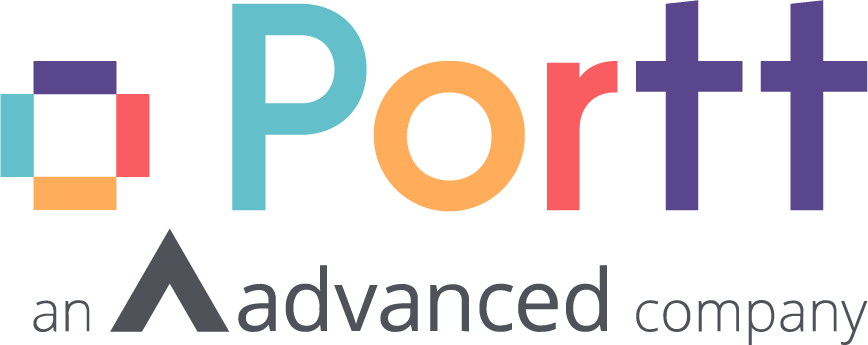3 Steps to Understanding Your Contract Management Maturity
A fully matured contract lifecycle management process is like a mighty oak tree: a sturdy repository of nourishment and stability in symbiosis with the surrounding forest. Think of each leaf as a contract, with all contracts gathered in a central place, each leaf-laden branch connected to the central trunk with full visibility, connectedness and control.
Unfortunately, most procurement teams’ contract lifecycle management maturity is more like a series of underdeveloped pot plants: a group of, disconnected processes which, even with watering and tendering, will never reach full maturity.
For others, contract lifecycle management is a dormant seed just needing a little TLC to start growing into something fruitful.
In this article, we’ll provide practical tips for first understanding, and then optimising your contract management maturity.
First things first: An intro to contract lifecycle management maturity
To understand contract lifecycle management (CLM) maturity, we first need to examine Contract lifecycle management. Contract lifecycle management encompasses governance and compliance, risk management, performance management and financial management across the entire lifecycle of a contract, from planning to sourcing, awarding and offboarding.
CLM maturity describes the sophistication level of an organisation’s contract lifecycle management: this maturity can range from ad hoc to fully optimised and integrated.
Sounds great! So, how do I increase my CLM maturity?
Contract lifecycle management maturity, or CLM maturity, is a tide that rises all aspects of CLM with it, increasing efficiency and, when full maturity is reached, turning contract management into an essential value-adding aspect of your business.
So, how do we reach that value-adding stage?
- Step 1: Understanding the contract lifecycle management maturity curve
- Step 2: Identifying your current contract management maturity level
- Step 3: Creating a pathway to increase your CLM maturity
Step 1: The maturity curve: 4 stages of CLM maturity
There are four distinct stages to the CLM maturity curve: ad hoc, basic, structured, and integrated and optimised. Let’s have a look at each stage and what they mean for your procurement process.
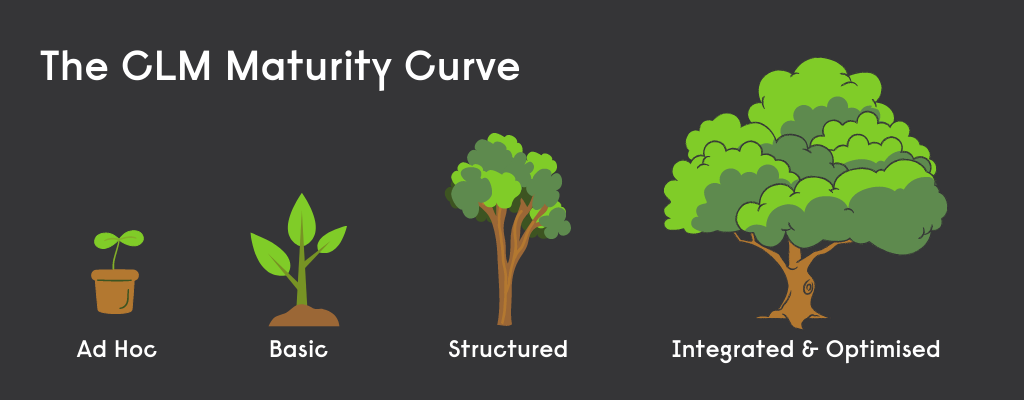
Ad Hoc
At the Ad Hoc stage, a procurement team may understand the basic concepts of contract lifecycle management. There may be a handful of contract management processes in place but they’ll only be sporadically applied with little or no cohesion across the procurement team. There are no contract lifecycle management processes or procedures in place, no formalised documentation and no accountability for compliance.
This stage is characterised by minimal or non-existent integration between departments, limited acquisition planning, weak supplier engagement and minimal stakeholder collaboration.
Issues you might be facing at the Ad Hoc stage: Contract obligations going unfulfilled, a lack of risk identification, contract triggers are missed.
Basic
At the Basic stage of the CLM maturity curve, your procurement team may have some formal documentation in place but no consistently implemented or used CLM processes. They may be finding it difficult to get buy-in from senior management and therefore can’t roll out CLM processes throughout the procurement team or integrate them with other departments.
At this stage, we see more central management and planned integration, some processes and standards in place but still a lack of consistency across processes. There may still be cumbersome paper-based contracts in use.
Issues you might be facing at the Basic stage: Poorly drafted contracts, missing key deadlines, lack of skill acquisition, contract deliverables are not being met.
Structured
Once you reach the Structured stage, you should have institutionalised and enforceable standards and procedures. Senior management should endorse your contract lifecycle management framework and be supportive and involved in the CLM process. At this stage, with a solid agreed-upon structure in place, you should be able to start taking a bespoke approach to each contract.
Issues you might be facing at this stage: Trust without verification, push back and resistance, poor documentation quality.
Integrated & Optimised
At the Integrated and Optimised stage CLM is seen as a value-adding service. You’ll have gained superior visibility and clarity over supplier and contract risk allowing you to make better business decisions. Your contract lifecycle management is now integrated with other enterprise ERP systems, generating a more efficient procurement process that drives efficiency and results both within and beyond the procurement department. At this stage, contract management is a required skill and one that is continually honed and optimised.
Step 2: Which stage are you at?
So, where do you land on the contract lifecycle management maturity curve? Use the checklists below to assess your current CLM maturity.
Note: You may fall somewhere in between, or you might tick some boxes across all four stages.
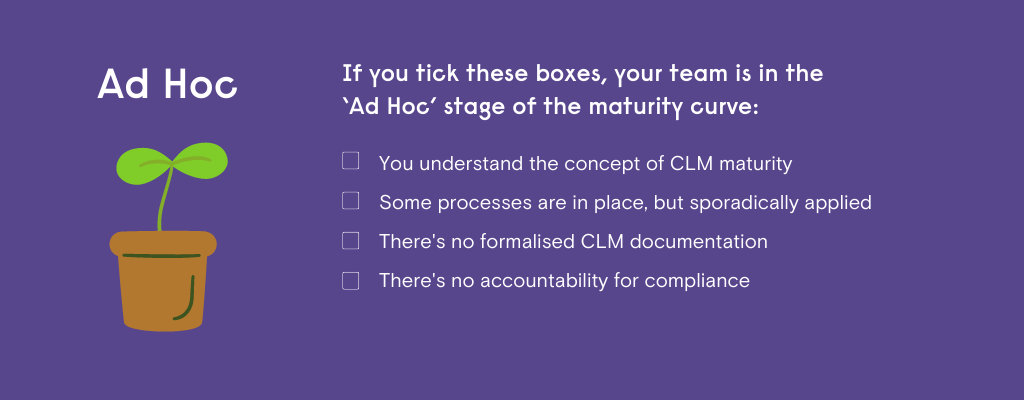

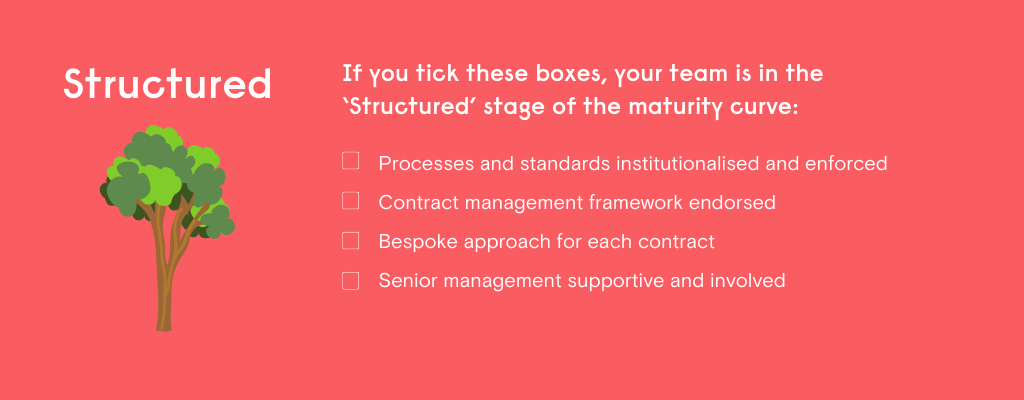

Step 3: Your pathway to CLM maturity
So, you’ve plotted your point on the CLM maturity curve. The next step is advancing your CLM maturity.
Optimising your contract management involves lots of moving parts and so requires a collaborative and strategic approach. We’ve created a contract management maturity roadmap with practical steps to take you from Ad Hoc to Optimised and Integrated.
Moving from Ad Hoc to Basic
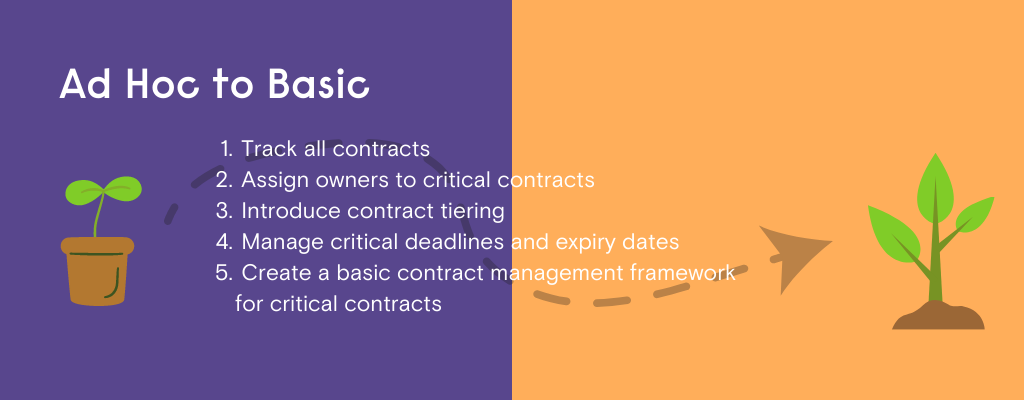
To move from Ad Hoc to Basic CLM maturity, you need to take ownership of your contracts. You should have visibility over where your contracts live, assign owners to critical contracts and introduce contract tiering to assign different values and management requirements to various contracts.
Tracking and managing important deadlines and expiry dates and creating a simple contract management framework for vital contracts will also help take your CLM maturity from Ad Hoc to Basic. If you’ve implemented these steps, congratulations! You’ve taken the first steps on your journey to fully realised CLM maturity.
Moving from Basic to Structured
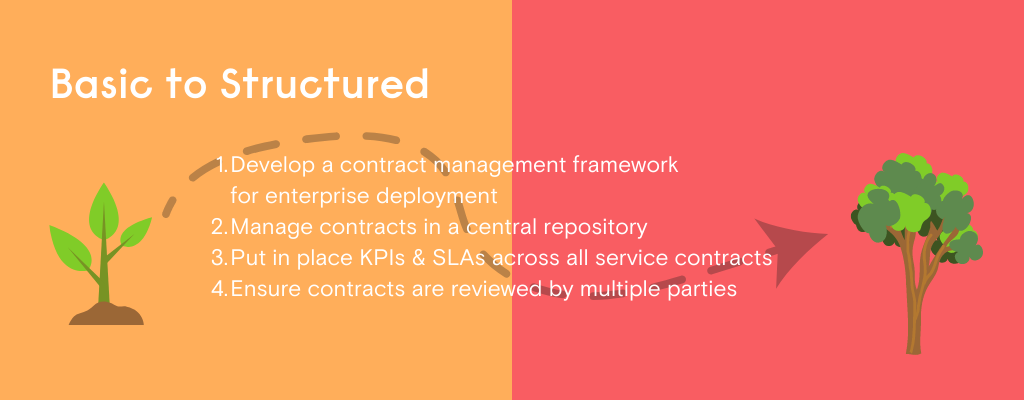
To move from Basic to Structured CLM maturity you need to establish frameworks and processes for your contract management. You need to create a central repository for all contracts, providing visibility and providing easy, accessible collaboration.
At this stage, you should also set up KPIs and SLAs across your contracts to track performance and measure results – collecting this data will be crucial to moving from Structured to Integrated and Optimised! Your contracts should be reviewed and approved by multiple stakeholders to ensure quality control and make sure your frameworks and processes are being followed.
Moving from Structured to Integrated & Optimised
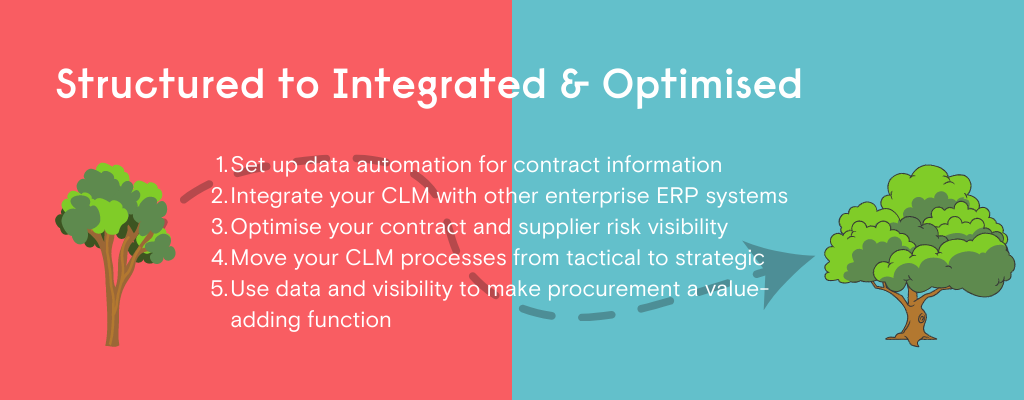
The final stage in the CLM maturity curve is Integrated and Optimised – at this point contract lifecycle management is fully incorporated with other ERP enterprise systems for a seamless, centralised CLM experience. To move from Structured to Integrated and Optimised CLM maturity, you need to optimise your contract risk and supplier risk visibility and take a strategic, rather than reactive, approach to your CLM processes.
The KPIs, SLAs, processes and frameworks established at the Structured phase will now be used to continually optimise performance, identify gaps in your contract lifecycle and achieve the goal of procurement as a value-add service.
How contract lifecycle management software can help
Contract lifecycle management is a perpetual opportunity to add value to your procurement process, and your entire enterprise. With the right care, your CLM can flourish and provide a central, cohesive environment for your enterprise to thrive.
The key to increasing your CLM maturity is visibility, control and integration. You need to gain visibility over your contracts, suppliers, stakeholders, milestones, risk management and a range of other moving parts in order to make smart, value-adding decisions.
Portt’s contract lifecycle management software is the solution. With superior cost management, automation, templates, strategic task capabilities and collaborative contract management, you can take your CLM from a seedling to a towering oak in no time!
